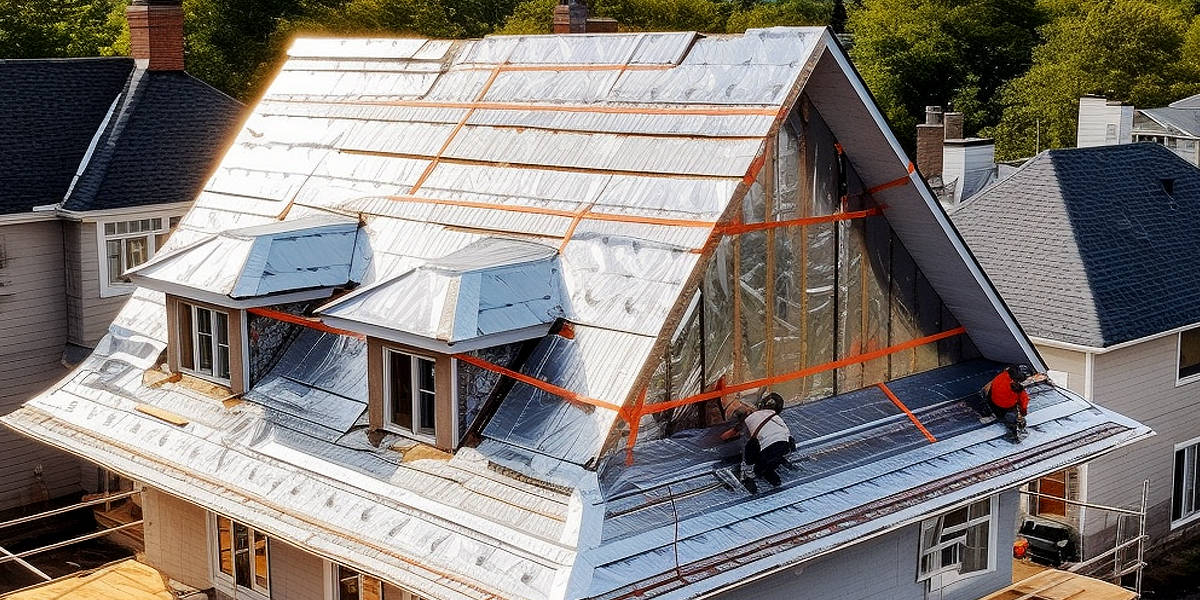Importance of Selecting the Right Roofing Material
Selecting the right roofing material is a crucial decision when it comes to building or renovating your home. The roof serves as the first line of defense against the elements, providing protection and insulation for your property. With a wide range of roofing options available in the market, it is essential to choose a roof type that not only complements the aesthetics of your home but also meets your specific needs in terms of durability, maintenance, and cost-effectiveness.
The right roofing material can significantly impact the longevity and performance of your roof. It should be able to withstand harsh weather conditions such as heavy rain, strong winds, snowfall, and extreme temperatures. Additionally, it should be resistant to common issues like leaks, rotting, and corrosion.
Moreover, selecting an appropriate roofing material can also have a significant impact on energy efficiency. Certain materials offer better insulation properties that help regulate indoor temperature and reduce energy consumption for heating or cooling purposes.
In this post, we will explore various types of roofing materials available in the market today. We will discuss their advantages and disadvantages along with factors to consider when choosing the right roof for your home. By understanding these aspects, you will be equipped with valuable knowledge to make an informed decision that ensures both functionality and aesthetic appeal for your property.
Factors to Consider When Selecting a Roofing Material
Climate and Weather
When selecting a roofing material, it’s important to consider the specific climate conditions of your area. Factors such as temperature, precipitation, and overall weather patterns play a crucial role in determining the most suitable roofing option for your home or building.
In hot climates, roofs are exposed to intense sunlight and high temperatures. It is essential to choose materials that can withstand these conditions without deteriorating or losing their effectiveness. Options such as clay tiles, metal roofs with reflective coatings, or concrete tiles can be excellent choices for hot climate roofs as they offer durability and heat resistance.
On the other hand, in cold climates where freezing temperatures and heavy snowfall are common, it is crucial to select roofing materials that can handle the weight of snow and provide adequate insulation. Asphalt shingles are often preferred due to their ability to withstand freezing temperatures and their affordability. Metal roofs are also a popular choice as they shed snow easily and have excellent durability.
For rainy climates where heavy rainfall is frequent, it is important to choose roofing materials that offer superior waterproofing properties. Options such as slate tiles or synthetic roofing materials like rubber or PVC can be effective choices for rainy climate roofs due to their water resistance capabilities.
In summary, when selecting a roofing material, considering the specific climate conditions of your area is crucial. By choosing a material that aligns with the demands of your climate – whether it’s hot, cold, or rainy – you can ensure long-lasting protection for your property while minimizing potential issues associated with weather-related damages.
Budget
Selecting the right roofing material for your home or building is an important decision that can impact the longevity, appearance, and overall value of your property. One of the key factors to consider when making this choice is your budget. Fortunately, there are a range of affordable and cost-effective options available in the market.
When looking for affordable roofing materials, it’s important to consider both the upfront cost as well as the long-term maintenance expenses. Some materials may have a lower initial price tag but require more frequent repairs or replacements, leading to higher overall costs over time. On the other hand, investing in a higher-quality material upfront may result in lower maintenance expenses down the line.
Asphalt shingles are a popular choice for those on a budget. They are one of the most cost-effective roofing options available and offer durability and versatility. Another affordable option is metal roofing, which can be more expensive initially but has a longer lifespan and requires less maintenance compared to other materials.
Additionally, considering energy efficiency can help save costs in the long run. Certain roofing materials have superior insulation properties that can reduce heating and cooling expenses by keeping your home better insulated throughout the year.
It’s also worth exploring different manufacturers and suppliers to find competitive pricing without compromising on quality. Researching customer reviews and warranties offered by different companies can provide insights into their reliability and product longevity.
Ultimately, finding an affordable roofing material that fits within your budget involves weighing factors such as initial cost, long-term maintenance expenses, energy efficiency benefits, and manufacturer reputation. By carefully considering these factors while keeping your budget in mind, you can select a roofing material that offers both affordability and durability for your property.
Durability and Longevity
When it comes to selecting a roofing material, durability and longevity are two crucial factors to consider. A long-lasting roof not only provides protection for your home but also saves you the hassle and cost of frequent repairs or replacements.
Several roofing options offer exceptional durability and can withstand harsh weather conditions. Materials like metal, slate, concrete tiles, and certain types of asphalt shingles are known for their longevity. These materials are designed to resist damage from wind, rain, hail, and UV rays.
Additionally, it’s essential to assess the lifespan of different roofing materials. Some materials have a longer life expectancy than others. For example, metal roofs can last up to 50 years or more with proper maintenance, while asphalt shingles typically have a lifespan of around 20-30 years.
Consider the local climate as well when choosing a durable roofing material. If you live in an area prone to extreme weather events such as hurricanes or heavy snowfall, opt for materials that have been tested and proven to withstand these conditions.
Furthermore, it’s worth exploring the warranty options provided by manufacturers for various roofing materials. A longer warranty period often indicates that the manufacturer has confidence in the durability of their product.
In conclusion, when selecting a roofing material for your home, prioritize durability and longevity. Look for options that can withstand severe weather conditions specific to your area and consider the expected lifespan of each material. By doing so, you can ensure that your roof remains sturdy and reliable for many years to come.
Aesthetics
When it comes to selecting a roofing material, aesthetics play a significant role. After all, the roof is one of the most visible parts of a building’s exterior and can greatly impact its overall appearance. Choosing visually appealing roofs and stylish roofing materials can enhance the curb appeal of your property while adding a touch of elegance and sophistication.
There are various roofing materials available in the market that offer different styles and designs to suit different architectural styles and personal preferences. For instance, clay or concrete tiles provide a classic and timeless look, while slate offers a natural and rustic charm. Metal roofs come in a range of colors and finishes, allowing for versatility in design.
It is essential to consider how well the roofing material complements the overall aesthetic of your property. Take into account factors such as color coordination with the exterior walls, architectural style compatibility, and neighborhood guidelines or restrictions.
By carefully considering aesthetics when selecting roofing materials, you can ensure that your roof not only serves its functional purpose but also adds value to your property by enhancing its visual appeal.
Maintenance Requirements
When it comes to selecting a roofing material for your home or commercial building, one important factor to consider is the maintenance requirements. Low maintenance roofs not only save you time and energy but also help to prolong the lifespan of your roof. Therefore, it is crucial to choose easy-to-maintain roofing materials that require minimal upkeep.
Some roofing materials, such as asphalt shingles and metal roofs, are known for their low maintenance needs. These materials are durable and resistant to common issues like leaks and cracks. Additionally, they require less frequent inspections and repairs compared to other options.
Another aspect to consider is the ease of cleaning. Some roofing materials, like metal or slate, can be easily cleaned with water and mild detergent without causing any damage. On the other hand, certain materials such as wood shakes or tiles may require more specialized cleaning methods.
Furthermore, it is essential to assess the long-term costs associated with maintaining different roofing materials. While some options may have a higher upfront cost, they may require less ongoing maintenance in terms of repairs or replacement over time.
Lastly, consider climate factors when selecting a low-maintenance roofing material. Different regions have varying weather conditions that can impact the longevity of certain roofs. For example, if you live in an area prone to heavy rainfall or extreme heat, choosing a material that can withstand these conditions with minimal upkeep will be advantageous.
Overall, when choosing a roofing material with low maintenance requirements, it’s important to consider durability against common issues, ease of cleaning, long-term costs implications and suitability for your specific climate conditions. By taking these factors into account during your selection process, you can ensure that you have an easy-to-maintain roof that will stand the test of time.
Noise Insulation
When selecting a roofing material, it is important to consider various factors that will contribute to the overall functionality and comfort of your home. One key aspect to take into account is noise insulation. Living in a noisy environment can be disruptive and affect your quality of life. Therefore, it is crucial to choose a roofing material that offers soundproofing properties or has noise-reducing characteristics.
Certain roofing materials are known for their ability to minimize external noise and provide a quieter indoor environment. For example, metal roofs have been found to effectively reduce noise from rain, hail, and other external sources due to their solid structure. Additionally, clay or concrete tiles can also help dampen sound vibrations as they are thicker than other materials.
It’s essential to consider the level of noise insulation you require in relation to your specific needs and location. If you live in an area with heavy rainfall or frequent storms, opting for a roofing material with excellent noise reduction capabilities may be beneficial. On the other hand, if you reside in a quiet neighborhood or have minimal external disturbances, this factor may not be as critical.
In conclusion, when choosing a roofing material, don’t overlook the importance of noise insulation. Consider factors such as the local climate conditions and surrounding environment before making your decision. By selecting a roof that effectively reduces exterior noises, you can create a more peaceful and comfortable living space for yourself and your family.
Fire Resistance
When it comes to selecting a roofing material, fire resistance is an important factor to consider. Fires can be devastating, causing significant damage to properties and endangering lives. Therefore, opting for a roofing material with good fire-resistant properties can provide added protection and peace of mind.
Certain materials, such as asphalt shingles and metal roofs, have excellent fire resistance capabilities. Asphalt shingles are manufactured with a fiberglass mat that is coated with asphalt and ceramic granules. This composition helps them resist the spread of flames in case of a fire incident.
Metal roofs are another popular choice for their outstanding fire-resistant qualities. They are non-combustible and do not support the spread of flames. Metal roofs also have the advantage of being able to withstand high temperatures without warping or melting.
On the other hand, materials like wood shakes or cedar shingles may not fare as well in terms of fire resistance. These natural materials can ignite easily when exposed to flames, making them less suitable for areas prone to wildfires or where fire safety is a concern.
It’s important to check if your chosen roofing material meets local building codes and regulations regarding fire resistance. Additionally, consider consulting with professionals or experts in the field who can provide guidance on selecting the most appropriate roofing material for your specific needs and location.
By prioritizing fire-resistant roofing materials, you can enhance the safety of your property and minimize potential risks associated with fires.
Sustainability
When it comes to selecting a roofing material, one crucial factor to consider is sustainability. With the growing concern for the environment, more and more homeowners are opting for eco-friendly roof options. These green roofing materials not only contribute to a healthier planet but also offer several benefits for homeowners.
One popular choice for sustainable roofing is the use of recycled materials. Materials such as recycled metal or shingles made from recycled rubber can help reduce waste and minimize the environmental impact. Additionally, these materials are often durable and long-lasting, meaning less frequent replacements and less waste generated over time.
Another eco-friendly option is the installation of a green roof or living roof. These roofs are covered with vegetation, providing numerous environmental benefits. Green roofs help improve air quality by absorbing carbon dioxide and releasing oxygen into the atmosphere. They also act as natural insulation, reducing energy consumption by keeping buildings cooler in summer and warmer in winter.
Furthermore, sustainable roofing materials often have energy-saving properties. For instance, some reflective roof coatings can reflect sunlight and reduce heat absorption, resulting in lower cooling costs during hot summer months.
Lastly, it is essential to consider whether the roofing material can be easily recycled at the end of its lifespan. Opting for a material that can be reused or repurposed rather than ending up in a landfill contributes to overall sustainability efforts.
In conclusion, when selecting a roofing material, it is important to prioritize sustainability. Eco-friendly options such as recycled materials or green roofs provide numerous advantages both for the environment and homeowners alike. By considering these factors carefully, you can make an informed decision that aligns with your values while ensuring a long-lasting and environmentally responsible roof for your home.



